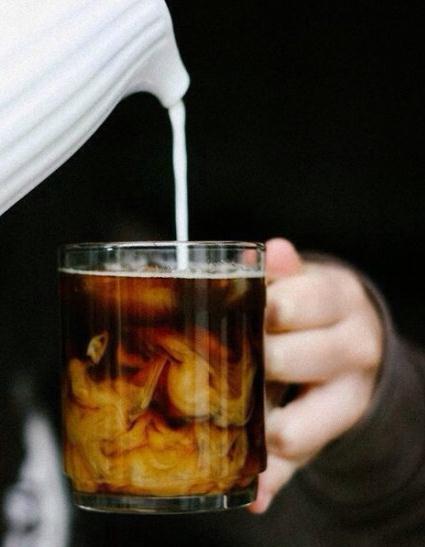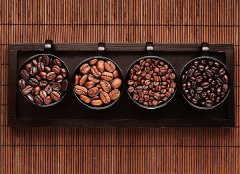Essentials of making Italian Coffee with knowledge of Coffee

1. Prepare knowledge. Understand the correct operation process of the coffee machine steam system, understand the purpose of the empty steam pipe before and after foam, and understand the importance of towels and easy cleaning in coffee making. Learn how to use the sprinkler to touch the milk noodles, the location and depth of the selected points.
two。 Two temperature problems. One is the starting and ending temperature of foaming, and the other is the temperature at which the milk foam is made. These two temperatures are very important for beginners, which is directly related to the mastery of the principle of foam. First of all, when it comes to foaming, the milk is cold at first (preferably refrigerated at 5 ℃), which can prolong the foaming time so that it can be fully foamed and delicate, and then open the steam valve to foam the milk. When foaming is consistent with our body temperature (feel neither hot nor cold), the foaming is cut off. Next, let's talk about the temperature at the end of milking. I just want to talk about what the temperature feels like on the hand. When we feel this temperature with our hands (in continuous heating), it is hot, but we can stand it for two or three seconds; as soon as we feel warm, we stop heating (the back end of the heating feels very hot on the hand, but it can hold it).
In some places, thermometers are used to measure. I think this kind of teaching method is not good. Technology is something that people need to understand attentively, and it is not very good for people to improve their own skills with the help of external forces. Xiaohan thinks that scientific metrology is also good, so it is very difficult for traditional Chinese medicine to pass on.
3. It's the angle. Know a dead angle between a foam-drawing jar and the steam tube of a coffee machine. After watching a lot of domestic and foreign baristas beating milk foam, coupled with their own constant attempts, I found that playing milk foam has a dead angle, just like playing video games, some dead corners can not hit you, but you can hit others. This angle is very troublesome to say in words, probably because the nozzle of the flower jar must be lifted, and the cylinder block should be tilted according to the rotation direction of the foam.
4. The vortex problem. The function of the vortex is to pull the coarse foam below the liquid surface through the vortex to make the surface clean. There are many states of a vortex, each of which needs to be observed and remembered. This point is so deep, let me keep it simple. If you want to have a vortex, the sprinkler of the steam pipe should not be too deep under the milk noodles.
5. Pull the vat movement problem. The sprinkler is in good contact with the milk, that is, open the steam valve, and the vat moves down very slowly, and you will hear the steam of "eating"cut" with the milk (about the shear force, when we discuss the principle of milk foaming later, talk slowly!) The sound made is commonly known as "the sound of air intake". The sound of air intake to human body temperature can no longer appear, otherwise, there will be a lot of coarse foam on the surface. At this point, move the flower jar up a little bit (just a little bit, which is important, which is understood by many people as moving up continuously, which is very wrong), and let the steam sprinkler leave the cutting surface so that the sound of "eating" can not be heard. At this point, by adjusting the angle of the vat, remember that it is the angle, not the position of the sprinkler and the surface (very small angle adjustment), find the vortex, pull the coarse foam off the surface in the foaming stage, and continue until the temperature reaches the hot temperature.
6. The amount of steam is a problem. I often see this description in some materials: when making milk foam, as soon as the nozzle touches the milk noodles, all the steam valves will be opened. I don't quite agree with this (except for the two-stage steam valve, because there is no way to operate the steam volume, here I refer to the mainstream knob steam valve). In fact, this view is not too big a problem, but as a beginner, the weight of the opponent is not controlled, the valve button is often screwed. Even for coffee lovers, I think it is best not to use this guiding ideology to operate steam valves. Back to the subject, let's talk about air pressure. After the air pressure is formed in the boiler, we open the steam valve, no matter how much it is opened, the steam is sprayed out at this pressure. It's just that the volume is a little small, not the pressure. I suggest that you only need to open the valve to the range where you can foam normally, there is no need to open it all. If you accept this theory, the coffee maker valve in your store will live a long life. If I accept this point of view, I will talk about how to develop this professional habit. For example, your coffee machine only needs to be twisted three times in the open direction (remember, three times, not three laps) to emit enough steam for foam, so please use this method to operate the steam valve of your coffee machine in the future. Open three times and close three times. Of course, if it takes two or four turns to get enough steam, follow the above method, and so on. In this way, the valve will no longer be closed too tightly or opened to the slippery wire. Congratulations on the longevity of your valve!
7. A pig-killing scream problem. Milk does not foaming this process, or the amount of foaming is very small, it will produce this sound. The direct reason is that the sprinkler is too deep below the surface of the milk. The way to avoid it is to move the flower jar down so that the sprinkler does not go too deep into the surface of the milk, and the sound immediately disappears, in exchange for the "eating" sound we want to hear.
8. Steam control problem. That is, no matter how much air pressure is used (in the allowable range of the boiler, personal understanding: 0.8-1.2bar), it can produce very good quality milk foam. First, establish a premise: use the 600ml medium pull vat (old-fashioned), hit a jar full of milk foam, and make the WBC standard two cups of foam thickness in 1cm cappuccino. This topic refers to the problem of foam distribution, that is, how to make the foam thickness of two cups of cappuccino consistent. Our slightly experienced operators all know that there are some tricks to achieve this, which is not difficult to master, but you must have a deep understanding of the state of the milk foam in the jar.
9. The problem of foam control. It mainly includes the following aspects: first, the degree of foam foaming. The degree of foam foaming is the most difficult to practice a kind of control, this control requires the operator to have a strong understanding ability, can understand the principle of milk foaming. The simplest and feasible control method is that it is better to rely on the middle than to the side, and it is better to rely on the top than on the bottom. How do you understand this? The closer the nozzle is to the middle of the vat (but try not to be in the middle of it, otherwise it is uncontrollable), the more foaming, the stronger; the closer to the cylinder wall (but not too close to the cylinder wall, which will affect the intake), the less the amount of foam. The closer the nozzle is to the liquid surface before the first temperature is reached, the more foaming will be. And vice versa! What's the use of practicing this control? As mentioned earlier, there are several criteria for making milk bubbles, one of which is to beat as many milk bubbles as you want; if you want to hit seven points, you will never hit nine points; if you make a cup of product, you will never measure two cups of milk bubbles; each time the cappuccino produced must be consistent in terms of foam quality. In this control exercise, there is a three-point theory (see figure). These three points are: cylinder nozzle, cylinder handle and sprinkler, these three points are in a straight line, by adjusting the distance between point 1 and point 2, to control the degree of milk bubbles. The second is the cleanliness of the surface of milk foam. This is a relatively easy control exercise. We talked about a dead corner of foam earlier. Although the understanding of milk foam to a certain extent, the angle is no longer important, but for beginners or operators who have not yet understood the principle of milk foaming, this angle should be mastered. This angle is very interesting. in the competition, the angle of milk foam of many champions at home and abroad is like this, because it cannot be said in words, and I cannot help you understand it hand in hand. Then please go to find some videos where the foam is well played, and you can find it casually on the Internet. If you can't find it all the time, buy another one when the author's book is published. I will make a video. I hope this can be solved. Here, by the way, a way to watch the video, do not look inside the flower jar, the internal picture I have drawn, mainly look at the relationship between the flower jar and the coffee machine, and the steam pipe. Keep looking, looking hard, until you find a feeling. By the way, some books on coffee from Taiwan that have been circulated on a small scale in China are also misleading to this issue. Before saying this misleading, I would like to make it clear that I have absorbed a lot of useful coffee information and learned a lot of methods in such books. I would like to express my thanks to the authors here. Now let's talk about misleading. In the diagrams of these books, many of them put the vats flat, which is not very suitable for beginners. Personal opinion: do not imitate!
four。 The key link of milking (manual and machine learning)
1. The treatment of milk foam, the key step. After the milk is dismissed, it is not the ideal foam, but in a layered state. The lower layer is the heated milk, and the upper layer is the "foam" after the milk is dismissed, so we have to deal with the milk after discarding. Shake up and down to remove the coarse foam from the surface; shake so that the hot milk is fully mixed with the upper foam to form foam. This step can also be achieved by reversing two jars (I prefer this method). This step is very critical, some friends do not attach great importance to this point, then all previous efforts will be wasted.
Pour the finished product back and forth several times in two jars, fully mix the hot milk and foam, then divide them equally between the two jars, and then pour back and forth a few times "in a small amount" so that they are evenly distributed. Many friends only do the front action and do not do a small amount of distribution in the back, so there will be unevenness. Of course, it's hard to understand if you describe it in words, but you'll understand if you try to do it a few times. To put it simply, it is to allocate the amount of milk foam. By using this method, the thickness of the foam in the two cups can be achieved.
A few tips: first, before pulling flowers, the milk foam has been in a shaking state in the flower jar to avoid the stratification caused by this to appear again, this is a professional habit, which must be developed. Second, if there is a small ball of milk foam concentrated in the middle of the vortex formed when shaking, which proves that the milk foam is unevenly distributed, it needs to be distributed again; third, before the product is produced, pour a little to the side, try the feel of the milk foam and then make the product. Fourth, when making a double-ring cappuccino, pay attention to the foam concentrated at the bottom of the flower jar, and try to live and stretch when scraping with a spoon.
two。 The requirements for the quality of milk foam. The first standard is that the surface should be reflective. Delicate, velvet-like, slippery. The second criterion is that there is no coarse foam on the surface. This requires a lot of foam control ability, of course, this is also the premise of reflection. Those larger than the diameter 1mm are called coarse foam. The third standard is: in the case of the same amount of milk (all added to the position at the bottom of the cylinder mouth), whether it is 60% full or 70%, 80%, 90% or full, the temperature should be the same. The fourth standard is to make two cups of cappuccino, using the WBC standard cup. After the foam is poured into the cup, there is no drop left in the jar. The above four standards have been achieved, and I think it is at least a good jar of milk foam in terms of vision, feel and technology. Earlier also mentioned a sense of hearing, which depends on the milk, just hit the milk foam, must not hear a very continuous burst sound, which can ensure the persistence of the milk foam in the cup.
Source: Chongqing Coffee training blog
Important Notice :
前街咖啡 FrontStreet Coffee has moved to new addredd:
FrontStreet Coffee Address: 315,Donghua East Road,GuangZhou
Tel:020 38364473
- Prev

The basic steps of coffee flower drawing heart and leaf diagram
The basic steps of coffee flower heart diagram: 1. Slowly inject milk into coffee, pay attention to grasp the height, do not destroy the coffee fat on the surface, the injection point of milk determines the flower pattern and basic position, we choose the milk injection point can be a little bit behind the center point of the cup. 2. When the cup of coffee and milk is close to 2/3 of the capacity, a lump has appeared around the injection point
- Next

I'll tell you what kind of coffee is a good cup of coffee.
A good cup of coffee, not to mention the taste, first of all, its taste, must be comfortable, so that you can feel that the coffee is clean and odorless. Just like the advertisement of so-and-so: the heart follows the heart, and the pleasure is silky and silky. 1. What is ESPRESSO about ESPRESSO: ①? Use about 8 grams of deep-roasted coffee beans, ground into coffee powder, and then pass through 9 atmospheric pressure
Related
- What is the meaning of lactic acid fermentation with coffee bean treatment?
- How to judge the state of foam by sound?
- How does the latte pull out the unicorn pattern? Come to get for a little trick to improve the flower pull!
- Will flower pulling affect the taste of the latte?
- Do you know the history of coffee?
- The difference between honey treatment and sun washing what is raisin honey treatment?
- What kind of milk can a novice use to make coffee foam to keep the foam longer? The correct method and skills of milking tutorial sharing
- Why do washed coffee beans taste sour? Flavor characteristics of washed Coffee
- Introduction to the skill of how to practice the size and height of water injection around the circle of hand-brewed coffee
- How do beginners practice coffee flower drawing from scratch?

